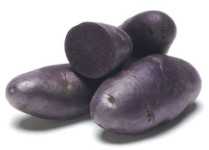Nutrient-Rich Spuds

Potatoes have gotten a bad rap the past few years, thanks to their nutritional value being overlooked by those invested in the “low-carb craze.” Researchers in the northwest, however, are trying to rectify the status of potatoes and are developing spuds with higher antioxidant nutrient levels.
These researchers from USDA’s Agricultural Research Service (ARS), Washington State University, the University of Idaho, and Oregon State University — the Tri-State Research Group — have added elements via traditional breeding that give color to potatoes, ranging from eggplant to crimson red. Oregon State University is taking the lead in developing, releasing, and marketing these specialty potatoes.
The element that gives the potatoes their color is called anthocyanin, an antioxidant, explains Chuck Brown, a USDA-ARS scientist. “A solid purple or red-fleshed potato has three or four times the antioxidant level than a regular potato and has antioxidant levels equivalent to broccoli or spinach,” he says.
Two potato varieties have emerged as a result of this research effort: a purple skin and purple-fleshed fingerling called Purple Pelisse and a red skin and red-fleshed variety known as AmaRosa.
One of the main benefits of these new varieties is that “consumers get a wider selection of potato varieties from which to choose, with the added benefit of consuming highly nutritious, palatable food,” says Mark Pavek, associate professor, Potato and Vegetable Crops at Washington State University. “Both of these varieties are conducive to grower profitability.”
Different Management Approach
These potatoes, however, are not managed in the same way as other spuds. “With fingerlings, you are managing for a specific size of potato and you are not interested in getting over-sized potatoes,” explains Brown. “Some of the tricks to growing these potatoes are not known because there is not enough experience on how to fertilize them, etc. but people will gradually gain experience in growing these.”
Brown says that he is a little surprised that colorful specialty potatoes haven’t exploded in volume, but he adds that an uncertain market may offer some explanation. “A seed grower hesitates to produce seed if he is not sure a grower will buy the seed,” he says. “The grower is hesitant to buy and produce a lot of anything if he is unsure he will have a buyer at the end of it.”
An Exclusive Variety
Trying something different to potentially increase the volume of the colorful fingerlings, last summer the Tri-State Research Group gave Purple Pelisse to the Klamath Basin Fresh Direct growers in Oregon as an exclusive variety.
Klamath Basin growers have a history of doing well with niche potatoes. Brown cites their variety Klamath Pearl, a small white potato marketed in a 3- to 5-pound bag in the San Francisco Bay area. About 150 acres are devoted to this variety, he says, and that seems to saturate the market.
The idea behind offering Purple Pelisse as an exclusive variety, says Brown, is that it would be the Klamath Basin growers’ “baby,” and they would invest in this variety and control it. “They can control supply and make sure it doesn’t go on huge acreage,” he explains.
The exclusive agreement, however, caused concern among seed potato growers. “We have a small seed industry in the state of Washington and when Purple Pelisse was made an exclusive, I thought the growers in Washington could be the seed producers,” says Brown. “The problem was they couldn’t sell the seed to other growers, only to the Klamath Basin growers. Furthermore, a number of seed growers were quietly developing customer interest and the exclusivity put an end to that.”
As a result, AmaRosa, which was released in May, will not be an exclusive variety. Growers who want to plant this variety will have to pay royalties,
says Brown.
“Right now, we have an experiment going on with one variety as an exclusive and one that is not exclusive,” he says. “In a few years we will see which one works better.”
Consumers will be the big winners in the end, having additional choices for potatoes. Purple Pelisse is a big draw for chefs, says Brown, but the jury is still out on AmaRosa. Because the red fingerling was just released, it will take some time to build up seed.
“There is a large seed industry in Idaho and smaller ones in Washington and Oregon. There is potential for volume here,” concludes Brown. “If someone wants to go with a specialty potato, they can go big time.”










